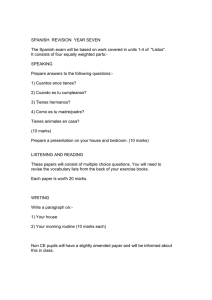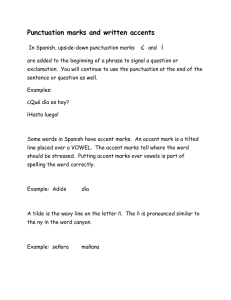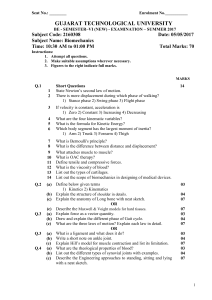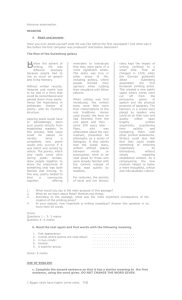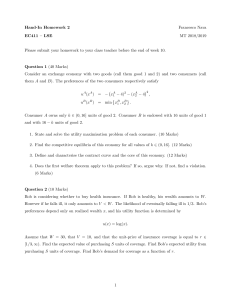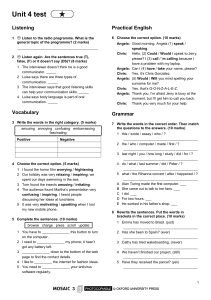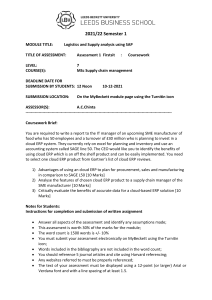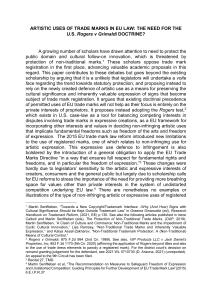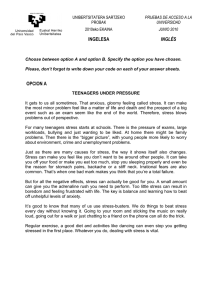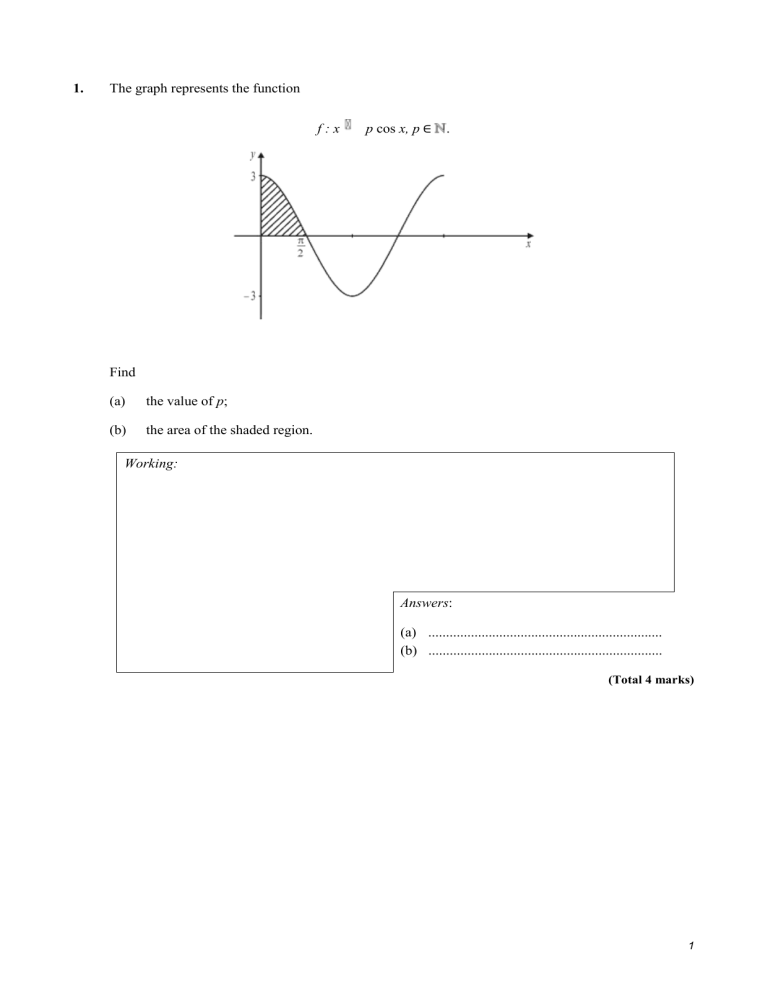
1. The graph represents the function f:x p cos x, p ∈ . Find (a) the value of p; (b) the area of the shaded region. Working: Answers: (a) .................................................................. (b) .................................................................. (Total 4 marks) 1 2. The function f is such that f ″ (x) = 2x – 2. When the graph of f is drawn, it has a minimum point at (3, –7). (a) Show that f′ (x) = x2 – 2x – 3 and hence find f (x). (6) (b) Find f (0), f (–1) and f′ (–1). (3) (c) Hence sketch the graph of f, labelling it with the information obtained in part (b). (4) (Note: It is not necessary to find the coordinates of the points where the graph cuts the x-axis.) (Total 13 marks) 3. The diagram shows part of the graph of y = (a) Find the coordinates of the point P, where the graph meets the y-axis. (2) The shaded region between the graph and the x-axis, bounded by x = 0 and x = ln 2, is rotated through 360° about the x-axis. (b) Write down an integral which represents the volume of the solid obtained. (4) (c) Show that this volume is π. (5) (Total 11 marks) 2 4. The diagram shows part of the graph of y = 12x2(1 – x). (a) Write down an integral which represents the area of the shaded region. (b) Find the area of the shaded region. Working: Answers: (a) .................................................................. (b) .................................................................. (Total 4 marks) 3 5. The diagram shows part of the graph of y = . The area of the shaded region is 2 units. Find the exact value of a. Working: Answer: ...................................................................... (Total 4 marks) 4 6. (a) Find the equation of the tangent line to the curve y = ln x at the point (e, 1), and verify that the origin is on this line. (4) (b) Show that (x ln x – x) = ln x. (2) (c) The diagram shows the region enclosed by the curve y = ln x, the tangent line in part (a), and the line y = 0. Use the result of part (b) to show that the area of this region is e – 1. (4) (Total 10 marks) 7. A curve has equation y = x(x – 4)2. (a) For this curve find (i) the x-intercepts; (ii) the coordinates of the maximum point; (iii) the coordinates of the point of inflexion. (9) (b) Use your answers to part (a) to sketch a graph of the curve for 0 ≤ x ≤ 4, clearly indicating the features you have found in part (a). (3) 5 (c) (i) On your sketch indicate by shading the region whose area is given by the following integral: (ii) Explain, using your answer to part (a), why the value of this integral is greater than 0 but less than 40. (3) (Total 15 marks) 8. If f ′(x) = cos x, and f = – 2, find f (x). Working: Answer: ...................................................................... (Total 4 marks) 9. (a) Sketch the graph of y = π sin x – x, –3 ≤ x ≤ 3, on millimetre square paper, using a scale of 2 cm per unit on each axis. Label and number both axes and indicate clearly the approximate positions of the x-intercepts and the local maximum and minimum points. (5) (b) Find the solution of the equation π sin x – x = 0, x > 0. (1) (c) Find the indefinite integral 6 and hence, or otherwise, calculate the area of the region enclosed by the graph, the x-axis and the line x = 1. (4) (Total 10 marks) 10. A curve with equation y =f (x) passes through the point (1, 1). Its gradient function is f′ (x) = –2x + 3. Find the equation of the curve. Working: Answer: ...................................................................... (Total 4 marks) 7 11. Given that f (x) = (2x + 5)3 find (a) f′ (x); (b) Working: Answers: (a) .................................................................. (b) .................................................................. (Total 4 marks) 8 12. The diagram shows the graph of the function y = 1 + area of the shaded region. , 0 < x ≤ 4. Find the exact value of the Working: Answer: ...................................................................... (Total 4 marks) 9 13. In this question you should note that radians are used throughout. (a) (i) Sketch the graph of y = x2 cos x, for 0 ≤ x ≤ 2 making clear the approximate positions of the positive x-intercept, the maximum point and the end-points. (ii) Write down the approximate coordinates of the positive x-intercept, the maximum point and the end-points. (7) (b) Find the exact value of the positive x-intercept for 0 ≤ x ≤ 2. (2) Let R be the region in the first quadrant enclosed by the graph and the x-axis. (c) (i) Shade R on your diagram. (ii) Write down an integral which represents the area of R. (3) (d) Evaluate the integral in part (c)(ii), either by using a graphic display calculator, or by using the following information. (x2 sin x + 2x cos x – 2 sin x) = x2 cos x. (3) (Total 15 marks) 10 14. In this part of the question, radians are used throughout. The function f is given by f (x) = (sin x)2 cos x. The following diagram shows part of the graph of y = f (x). The point A is a maximum point, the point B lies on the x-axis, and the point C is a point of inflexion. (a) Give the period of f. (1) (b) From consideration of the graph of y = f (x), find to an accuracy of one significant figure the range of f. (1) 11 (c) (i) Find f′ (x). (ii) Hence show that at the point A, cos x = (iii) Find the exact maximum value. . (9) (d) Find the exact value of the x-coordinate at the point B. (1) (e) (i) Find dx. (ii) Find the area of the shaded region in the diagram. (4) (f) Given that f″ (x) = 9(cos x)3 – 7 cos x, find the x-coordinate at the point C. (4) (Total 20 marks) 15. Let f′ (x) = 1 – x2. Given that f (3) = 0, find f (x). Working: Answer: .................................................................... (Total 4 marks) 12 16. Note: Radians are used throughout this question. (a) Draw the graph of y = π + x cos x, 0 ≤ x ≤ 5, on millimetre square graph paper, using a scale of 2 cm per unit. Make clear (i) the integer values of x and y on each axis; (ii) the approximate positions of the x-intercepts and the turning points. (5) (b) Without the use of a calculator, show that π is a solution of the equation π + x cos x = 0. (3) (c) Find another solution of the equation π + x cos x = 0 for 0 ≤ x ≤ 5, giving your answer to six significant figures. (2) (d) Let R be the region enclosed by the graph and the axes for 0 ≤ x ≤ π. Shade R on your diagram, and write down an integral which represents the area of R . (2) (e) Evaluate the integral in part (d) to an accuracy of six significant figures. (If you consider it necessary, you can make use of the result (3) (Total 15 marks) 13 17. Find (a) (b) . Working: Answers: (a) .................................................................. (b) .................................................................. (Total 4 marks) 14 18. The diagram below shows part of the graph of the function The graph intercepts the x-axis at A(–3, 0), B(5, 0) and the origin, O. There is a minimum point at P and a maximum point at Q. (a) The function may also be written in the form where a < b. Write down the value of (i) a; (ii) b. (2) (b) Find (i) f ′(x); (ii) the exact values of x at which f '(x) = 0; (iii) the value of the function at Q. (7) 15 (c) (i) Find the equation of the tangent to the graph of f at O. (ii) This tangent cuts the graph of f at another point. Give the x-coordinate of this point. (4) (d) Determine the area of the shaded region. (2) (Total 15 marks) 19. A ball is dropped vertically from a great height. Its velocity v is given by v = 50 – 50e–0.2t, t ≥ 0 where v is in metres per second and t is in seconds. (a) Find the value of v when (i) t = 0; (ii) t = 10. (2) (b) (i) Find an expression for the acceleration, a, as a function of t. (ii) What is the value of a when t = 0? (3) (c) (i) As t becomes large, what value does v approach? (ii) As t becomes large, what value does a approach? (iii) Explain the relationship between the answers to parts (i) and (ii). (3) 16 (d) Let y metres be the distance fallen after t seconds. (i) Show that y = 50t + 250e–0.2t + k, where k is a constant. (ii) Given that y = 0 when t = 0, find the value of k. (iii) Find the time required to fall 250 m, giving your answer correct to four significant figures. (7) (Total 15 marks) 20. The derivative of the function f is given by f ′(x) = – 0.5 sin x, for x ≠ –1. The graph of f passes through the point (0, 2). Find an expression for f (x). Working: Answer: ...................................................................... (Total 6 marks) 21. Consider functions of the form y = e–kx (a) Show that = (1 – e–k). (3) 17 (b) Let k = 0.5 (i) Sketch the graph of y = e–0.5x, for –1 ≤ x ≤ 3, indicating the coordinates of the y-intercept. (ii) Shade the region enclosed by this graph, the x-axis, y-axis and the line x = 1. (iii) Find the area of this region. (5) (c) (i) in terms of k, where y = e–kx. Find The point P(1, 0.8) lies on the graph of the function y = e–kx. (ii) Find the value of k in this case. (iii) Find the gradient of the tangent to the curve at P. (5) (Total 13 marks) 22. Let f (x) = (a) Find f′ (x); (b) Working: Answers: (a) .................................................................. (b) .................................................................. (Total 6 marks) 23. The diagram shows part of the curve y = sin x. The shaded region is bounded by the curve and 18 the lines y = 0 and x = Given that sin Working: = and cos =– , calculate the exact area of the shaded region. Answer: ...................................................................... (Total 6 marks) 19 24. The diagram below shows a sketch of the graph of the function y = sin (ex) where –1 ≤ x ≤ 2, and x is in radians. The graph cuts the y-axis at A, and the x-axis at C and D. It has a maximum point at B. (a) Find the coordinates of A. (2) (b) The coordinates of C may be written as (ln k, 0). Find the exact value of k. (2) (c) (i) Write down the y-coordinate of B. (ii) Find (iii) Hence, show that at B, x = ln . . (6) (d) (i) Write down the integral which represents the shaded area. (ii) Evaluate this integral. (5) 20 (e) (i) Copy the above diagram into your answer booklet. (There is no need to copy the shading.) On your diagram, sketch the graph of y = x3. (ii) The two graphs intersect at the point P. Find the x-coordinate of P. (3) (Total 18 marks) 25. In this question, s represents displacement in metres, and t represents time in seconds. (a) The velocity v m s–1 of a moving body may be written as v = = 30 – at, where a is a constant. Given that s = 0 when t = 0, find an expression for s in terms of a and t. (5) Trains approaching a station start to slow down when they pass a signal which is 200 m from the station. (b) The velocity of Train 1 t seconds after passing the signal is given by v = 30 – 5t. (i) Write down its velocity as it passes the signal. (ii) Show that it will stop before reaching the station. (5) (c) Train 2 slows down so that it stops at the station. Its velocity is given by v= = 30 – at, where a is a constant. (i) Find, in terms of a, the time taken to stop. (ii) Use your solutions to parts (a) and (c)(i) to find the value of a. (5) (Total 15 marks) 21 26. Given that = 10, deduce the value of (a) (b) Working: Answers: (a) .................................................................. (b) .................................................................. (Total 6 marks) 27. An aircraft lands on a runway. Its velocity v m s–1 at time t seconds after landing is given by the equation v = 50 + 50e–0.5t, where 0 ≤ t ≤ 4. (a) Find the velocity of the aircraft (i) when it lands; (ii) when t = 4. (4) (b) Write down an integral which represents the distance travelled in the first four seconds. (3) (c) Calculate the distance travelled in the first four seconds. (2) 22 After four seconds, the aircraft slows down (decelerates) at a constant rate and comes to rest when t = 11. (d) Sketch a graph of velocity against time for 0 ≤ t ≤ 11. Clearly label the axes and mark on the graph the point where t = 4. (5) (e) Find the constant rate at which the aircraft is slowing down (decelerating) between t = 4 and t = 11. (2) (f) Calculate the distance travelled by the aircraft between t = 4 and t = 11. (2) (Total 18 marks) 28. Consider the function f (x) = cos x + sin x. (a) (i) Show that f (– ) = 0. (ii) Find in terms of π, the smallest positive value of x which satisfies f (x) = 0. (3) 23 The diagram shows the graph of y = ex (cos x + sin x), – 2 ≤ x ≤ 3. The graph has a maximum turning point at C(a, b) and a point of inflexion at D. (b) Find . (3) (c) Find the exact value of a and of b. (4) (d) Show that at D, y = . (5) (e) Find the area of the shaded region. (2) (Total 17 marks) 29. It is given that = x3+2x – 1 and that y = 13 when x = 2. 24 Find y in terms of x. Working: Answer: .................................................................. (Total 6 marks) 25 30. (a) Find ∫(1 + 3 sin (x + 2))dx. (b) The diagram shows part of the graph of the function f (x) = 1 + 3 sin (x + 2). The area of the shaded region is given by . Find the value of a. Working: Answers: (a) .................................................................. (b) .................................................................. (Total 6 marks) 26 31. Consider the function f (x) = 1 + e–2x. (a) (i) Find f ′(x). (ii) Explain briefly how this shows that f (x) is a decreasing function for all values of x (ie that f (x) always decreases in value as x increases). (2) Let P be the point on the graph of f where x = – (b) . Find an expression in terms of e for (i) the y-coordinate of P; (ii) the gradient of the tangent to the curve at P. (2) (c) Find the equation of the tangent to the curve at P, giving your answer in the form y = ax + b. (3) (d) (i) Sketch the curve of f for –1 ≤ x ≤ 2. (ii) Draw the tangent at x = – (iii) Shade the area enclosed by the curve, the tangent and the y-axis. (iv) Find this area. . (7) (Total 14 marks) 27 32. (a) Consider the function f (x) = 2 + graph of y = f (x). . The diagram below is a sketch of part of the Copy and complete the sketch of f (x). (2) (b) (i) Write down the x-intercepts and y-intercepts of f (x). (ii) Write down the equations of the asymptotes of f (x). (4) (c) (i) Find f ′ (x). (ii) There are no maximum or minimum points on the graph of f (x). Use your expression for f ′ (x) to explain why. (3) 28 The region enclosed by the graph of f (x), the x-axis and the lines x = 2 and x = 4, is labelled A, as shown below. (d) (i) Find dx. (ii) Write down an expression that represents the area labelled A. (iii) Find the area of A. (7) (Total 16 marks) 33. The derivative of the function f is given by f ′ (x) = e–2x + , x < 1. The graph of y = f (x) passes through the point (0, 4). Find an expression for f (x). Working: Answer: …………………………………………........ (Total 6 marks) 34. Let f be a function such that . 29 (a) Deduce the value of (i) (ii) (b) If , write down the value of c and of d. Working: Answers: (a) (i) ........................................................ (ii) ....................................................... (b) c = ......................., d = ....................... (Total 6 marks) 30 35. Let h (x) = (x – 2) sin (x – 1) for –5 ≤ x ≤ 5. The curve of h (x) is shown below. There is a minimum point at R and a maximum point at S. The curve intersects the x-axis at the points (a, 0) (1, 0) (2, 0) and (b, 0). (a) Find the exact value of (i) a; (ii) b. (2) The regions between the curve and the x-axis are shaded for a ≤ x ≤ 2 as shown. (b) (i) Write down an expression which represents the total area of the shaded regions. (ii) Calculate this total area. (5) (c) (i) The y-coordinate of R is –0.240. Find the y-coordinate of S. (ii) Hence or otherwise, find the range of values of k for which the equation (x – 2) sin (x – 1) = k has four distinct solutions. (4) (Total 11 marks) 36. Let f (x) = . 31 (a) Write down the equation of the horizontal asymptote of the graph of f. (1) (b) Find f ′ (x). (3) (c) The second derivative is given by f ″(x) = . Let A be the point on the curve of f where the gradient of the tangent is a maximum. Find the x-coordinate of A. (4) (d) Let R be the region under the graph of f, between x = – and x = , as shaded in the diagram below Write down the definite integral which represents the area of R. (2) (Total 10 marks) 32 37. The function f is given by f (x) = 2sin (5x – 3). (a) Find f " (x). (b) Write down . ..................................................................................................................................... ..................................................................................................................................... ..................................................................................................................................... ..................................................................................................................................... ..................................................................................................................................... ..................................................................................................................................... ..................................................................................................................................... ..................................................................................................................................... ..................................................................................................................................... ..................................................................................................................................... ..................................................................................................................................... ..................................................................................................................................... (Total 6 marks) 33 38. The velocity v m s–1 of a moving body at time t seconds is given by v = 50 – 10t. (a) Find its acceleration in m s–2. (b) The initial displacement s is 40 metres. Find an expression for s in terms of t. ..................................................................................................................................... ..................................................................................................................................... ..................................................................................................................................... ..................................................................................................................................... ..................................................................................................................................... ..................................................................................................................................... ..................................................................................................................................... ..................................................................................................................................... ..................................................................................................................................... ..................................................................................................................................... ..................................................................................................................................... ..................................................................................................................................... (Total 6 marks) 39. The function f is defined by (a) Write down (i) f ′(x); (ii) f ′(0). (2) (b) Let N be the normal to the curve at the point where the graph intercepts the y-axis. Show that the equation of N may be written as y = –0.5x + 2.5. (3) 34 Let (c) (i) Find the solutions of f (x) = g (x). (ii) Hence find the coordinates of the other point of intersection of the normal and the curve. (6) (d) Let R be the region enclosed between the curve and N. (i) Write down an expression for the area of R. (ii) Hence write down the area of R. (5) (Total 16 marks) 40. The diagram below shows the graphs of f (x) = 1 + e2x, g (x) = 10x + 2, 0 ≤ x ≤ 1.5. (a) (i) Write down an expression for the vertical distance p between the graphs of f and g. (ii) Given that p has a maximum value for 0 ≤ x ≤ 1.5, find the value of x at which this occurs. (6) 35 The graph of y = f (x) only is shown in the diagram below. When x = a, y = 5. (b) (i) Find f –1(x). (ii) Hence show that a = ln 2. (5) (c) The region shaded in the diagram is rotated through 360° about the x-axis. Write down an expression for the volume obtained. (3) (Total 14 marks) 36 41. Let f (x) = (3x + 4)5. Find (a) f ′(x); (b) ∫f (x)dx. Working: Answers: (a) .................................................................. (b) .................................................................. (Total 6 marks) 42. The curve y = f (x) passes through the point (2, 6). Given that = 3x2 – 5, find y in terms of x. Working: Answer: ....…………………………………….......... (Total 6 marks) 37 43. The table below shows some values of two functions, f and g, and of their derivatives f ′ and g ′. x 1 2 3 4 f (x) 5 4 –1 3 g (x) 1 –2 2 –5 f ′(x) 5 6 0 7 g′ (x) –6 –4 –3 4 Calculate the following. (a) (f (x) + g (x)), when x = 4; (b) . Working: Answers: (a) .................................................................. (b) .................................................................. (Total 6 marks) 38 44. Given dx = ln 7, find the value of k. (Total 6 marks) 45. A particle moves with a velocity v m s−1 given by v = 25 − 4t2 where t ≥ 0. (a) The displacement, s metres, is 10 when t is 3. Find an expression for s in terms of t. (6) (b) Find t when s reaches its maximum value. (3) (c) The particle has a positive displacement for m ≤ t ≤ n. Find the value of m and the value of n. (3) (Total 12 marks) 39 46. The graph of y = sin 2x from 0≤ x ≤ π is shown below. The area of the shaded region is 0.85. Find the value of k. (Total 6 marks) 40 47. A part of the graph of y = 2x – x2 is given in the diagram below. The shaded region is revolved through 360° about the x-axis. (a) Write down an expression for this volume of revolution. (b) Calculate this volume. .............................................................................................................................................. .............................................................................................................................................. .............................................................................................................................................. .............................................................................................................................................. .............................................................................................................................................. .............................................................................................................................................. .............................................................................................................................................. .............................................................................................................................................. .............................................................................................................................................. .............................................................................................................................................. .............................................................................................................................................. .............................................................................................................................................. .............................................................................................................................................. (Total 6 marks) 48. Let f (x) = – x2 + x + 4. 41 (a) (i) Write down f ′ (x). (ii) Find the equation of the normal to the curve of f at (2, 3). (iii) This normal intersects the curve of f at (2, 3) and at one other point P. Find the x-coordinate of P. (9) Part of the graph of f is given below. (b) Let R be the region under the curve of f from x = −1 to x = 2. (i) Write down an expression for the area of R. (ii) Calculate this area. (iii) The region R is revolved through 360° about the x-axis. Write down an expression for the volume of the solid formed. (6) (c) Find giving your answer in terms of k. (6) (Total 21 marks) 49. Consider the functions f and g where f (x) = 3x – 5 and g (x) = x – 2. (a) Find the inverse function, f −1. (3) 42 (b) Given that g–1 (x) = x + 2, find (g–1 ◦ f) (x). (2) (c) Given also that (f −1 ◦ g) (x) , solve (f −1 ◦ g) (x) = (g–1 ◦ f) (x). (2) Let h (x) = (d) ,x 2. (i) Sketch the graph of h for −3 ≤ x ≤ 7 and −2 ≤ y ≤ 8, including any asymptotes. (ii) Write down the equations of the asymptotes. (5) (e) The expression following. may also be written as 3 + (i) Find (ii) Hence, calculate the exact value of . Use this to answer the dx. h (x)dx. (5) (f) On your sketch, shade the region whose area is represented by h (x)dx. (1) (Total 18 marks) 43 50. The velocity v in m s−1 of a moving body at time t seconds is given by v = e2t−1. When t = 0 5. the displacement of the body is 10 m. Find the displacement when t =1. .............................................................................................................................................. .............................................................................................................................................. .............................................................................................................................................. .............................................................................................................................................. .............................................................................................................................................. .............................................................................................................................................. .............................................................................................................................................. .............................................................................................................................................. .............................................................................................................................................. .............................................................................................................................................. .............................................................................................................................................. .............................................................................................................................................. .............................................................................................................................................. (Total 6 marks) 44 51. The shaded region in the diagram below is bounded by f (x) = , x = a, and the x-axis. The shaded region is revolved around the x-axis through 360°. The volume of the solid formed is 0.845π. Find the value of a. .............................................................................................................................................. .............................................................................................................................................. .............................................................................................................................................. .............................................................................................................................................. .............................................................................................................................................. .............................................................................................................................................. .............................................................................................................................................. .............................................................................................................................................. .............................................................................................................................................. .............................................................................................................................................. .............................................................................................................................................. .............................................................................................................................................. .............................................................................................................................................. (Total 6 marks) 52. The function f is defined as f (x) = (2x +1) e−x, 0 ≤ x ≤ 3. The point P(0, 1) lies on the graph of f (x), and there is a maximum point at Q. (a) Sketch the graph of y = f (x), labelling the points P and Q. (3) 45 (b) (i) Show that f ′ (x) = (1− 2x) e−x. (ii) Find the exact coordinates of Q. (7) (c) The equation f (x) = k, where k ∈ k. , has two solutions. Write down the range of values of (2) (d) Given that f ″(x) = e−x (−3 + 2x), show that the curve of f has only one point of inflexion. (2) (e) Let R be the point on the curve of f with x-coordinate 3. Find the area of the region enclosed by the curve and the line (PR). (7) (Total 21 marks) 46 53. The velocity v of a particle at time t is given by v = e−2t + 12t. The displacement of the particle at time t is s. Given that s = 2 when t = 0, express s in terms of t. .............................................................................................................................................. .............................................................................................................................................. .............................................................................................................................................. .............................................................................................................................................. .............................................................................................................................................. .............................................................................................................................................. .............................................................................................................................................. .............................................................................................................................................. .............................................................................................................................................. .............................................................................................................................................. .............................................................................................................................................. .............................................................................................................................................. .............................................................................................................................................. (Total 6 marks) 47 54. It is given that f (x)dx = 5. (a) Write down (b) Find the value of 2 f (x)dx. (3x2 + f (x))dx. .............................................................................................................................................. .............................................................................................................................................. .............................................................................................................................................. .............................................................................................................................................. .............................................................................................................................................. .............................................................................................................................................. .............................................................................................................................................. .............................................................................................................................................. .............................................................................................................................................. .............................................................................................................................................. .............................................................................................................................................. .............................................................................................................................................. .............................................................................................................................................. (Total 6 marks) 48 55. Let f ′ (x) = 12x2 − 2. Given that f (−1) =1, find f (x). .............................................................................................................................................. .............................................................................................................................................. .............................................................................................................................................. .............................................................................................................................................. .............................................................................................................................................. .............................................................................................................................................. .............................................................................................................................................. .............................................................................................................................................. .............................................................................................................................................. .............................................................................................................................................. .............................................................................................................................................. .............................................................................................................................................. .............................................................................................................................................. (Total 6 marks) 49 56. The function f is defined as f (x) = ex sin x, where x is in radians. Part of the curve of f is shown below. There is a point of inflexion at A, and a local maximum point at B. The curve of f intersects the x-axis at the point C. (a) Write down the x-coordinate of the point C. (1) (b) (i) Find f ′ (x). (ii) Write down the value of f ′ (x) at the point B. (4) (c) Show that f ″(x) = 2ex cos x. (2) (d) (i) Write down the value of f ″(x) at A, the point of inflexion. (ii) Hence, calculate the coordinates of A. (4) (e) Let R be the region enclosed by the curve and the x-axis, between the origin and C. (i) Write down an expression for the area of R. (ii) Find the area of R. (4) (Total 15 marks) 57. The function f (x) is defined as f (x) = 3 + ,x . 50 (a) Sketch the curve of f for −5 ≤ x ≤ 5, showing the asymptotes. (3) (b) Using your sketch, write down (i) the equation of each asymptote; (ii) the value of the x-intercept; (iii) the value of the y-intercept. (4) (c) The region enclosed by the curve of f, the x-axis, and the lines x = 3 and x = a, is revolved through 360° about the x-axis. Let V be the volume of the solid formed. (i) Find (ii) Hence, given that V = dx. , find the value of a. (10) (Total 17 marks) 51 58. Let f (x) = , where p, q∈ + . Part of the graph of f, including the asymptotes, is shown below. (a) The equations of the asymptotes are x =1, x = −1, y = 2. Write down the value of (i) p; (ii) q. (2) (b) Let R be the region bounded by the graph of f, the x-axis, and the y-axis. (i) Find the negative x-intercept of f. (ii) Hence find the volume obtained when R is revolved through 360° about the x-axis. (7) (c) (i) Show that f ′ (x) = (ii) Hence, show that there are no maximum or minimum points on the graph of f. . (8) (d) Let g (x) = f ′ (x). Let A be the area of the region enclosed by the graph of g and the x52 axis, between x = 0 and x = a, where a > 0. Given that A = 2, find the value of a. (7) (Total 24 marks) 59. The following diagram shows part of the graph of y = cos x for 0 ≤ x ≤ 2π. Regions A and B are shaded. (a) Write down an expression for the area of A. (1) (b) Calculate the area of A. (1) 53 (c) Find the total area of the shaded regions. .............................................................................................................................................. .............................................................................................................................................. .............................................................................................................................................. .............................................................................................................................................. .............................................................................................................................................. .............................................................................................................................................. .............................................................................................................................................. .............................................................................................................................................. .............................................................................................................................................. .............................................................................................................................................. .............................................................................................................................................. .............................................................................................................................................. (4) (Total 6 marks) 60. Consider the function f (x) e(2x–1) + (a) ,x . Sketch the curve of f for −2 ≤ x ≤ 2, including any asymptotes. (3) 54 (b) (i) Write down the equation of the vertical asymptote of f. (ii) Write down which one of the following expressions does not represent an area between the curve of f and the x-axis. f (x)dx f (x)dx (iii) Justify your answer. (3) (c) The region between the curve and the x-axis between x = 1 and x = 1.5 is rotated through 360° about the x-axis. Let V be the volume formed. (i) Write down an expression to represent V. (ii) Hence write down the value of V. (4) (d) Find f ′ (x). (4) (e) (i) Write down the value of x at the minimum point on the curve of f. (ii) The equation f (x) = k has no solutions for p ≤ k < q. Write down the value of p and of q. (3) (Total 17 marks) 55 61. (a) Find (2) (b) Given that = ln , find the value of P. .............................................................................................................................................. .............................................................................................................................................. .............................................................................................................................................. .............................................................................................................................................. .............................................................................................................................................. .............................................................................................................................................. .............................................................................................................................................. .............................................................................................................................................. .............................................................................................................................................. .............................................................................................................................................. .............................................................................................................................................. .............................................................................................................................................. (4) (Total 6 marks) 56 62. A particle moves along a straight line so that its velocity, v ms−1 at time t seconds is given by v = 6e3t + 4. When t = 0, the displacement, s, of the particle is 7 metres. Find an expression for s in terms of t. .............................................................................................................................................. .............................................................................................................................................. .............................................................................................................................................. .............................................................................................................................................. .............................................................................................................................................. .............................................................................................................................................. .............................................................................................................................................. .............................................................................................................................................. .............................................................................................................................................. .............................................................................................................................................. .............................................................................................................................................. .............................................................................................................................................. (Total 7 marks) 57 63. Let (a) Show that (2) (b) Find the value of .............................................................................................................................................. .............................................................................................................................................. .............................................................................................................................................. .............................................................................................................................................. .............................................................................................................................................. .............................................................................................................................................. .............................................................................................................................................. .............................................................................................................................................. .............................................................................................................................................. .............................................................................................................................................. .............................................................................................................................................. .............................................................................................................................................. (5) (Total 7 marks) 58 64. Let f : x sin3 x. (a) (i) Write down the range of the function f. (ii) Consider f (x) =1, 0 ≤ x ≤ 2π. Write down the number of solutions to this equation. Justify your answer. (5) (b) Find f ′ (x), giving your answer in the form a sinp x cosq x where a, p, q ∈ . (2) (c) Let g (x) = for 0 ≤ x ≤ . Find the volume generated when the curve of g is revolved through 2π about the x-axis. (7) (Total 14 marks) 59 65. The following diagram shows the graphs of f (x) = ln (3x – 2) + 1 and g (x) = – 4 cos (0.5x) + 2, for 1 ≤ x ≤ 10. (a) Let A be the area of the region enclosed by the curves of f and g. (i) Find an expression for A. (ii) Calculate the value of A. (6) (b) (i) Find f ′ (x). (ii) Find g′ (x). (4) (c) There are two values of x for which the gradient of f is equal to the gradient of g. Find both these values of x. (4) (Total 14 marks) 60 66. Let f (x) = ex (1 – x2). (a) Show that f ′ (x) = ex (1 – 2x – x2). (3) Part of the graph of y = f (x), for – 6 ≤ x ≤ 2, is shown below. The x-coordinates of the local minimum and maximum points are r and s respectively. (b) Write down the equation of the horizontal asymptote. (1) (c) Write down the value of r and of s. (4) (d) Let L be the normal to the curve of f at P(0, 1). Show that L has equation x + y = 1. (4) (e) Let R be the region enclosed by the curve y = f (x) and the line L. (i) Find an expression for the area of R. (ii) Calculate the area of R. (5) (Total 17 marks) 61
